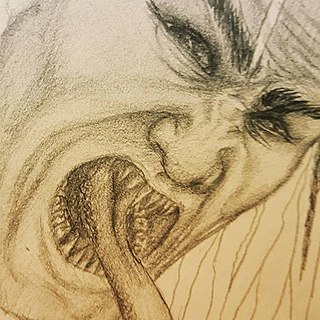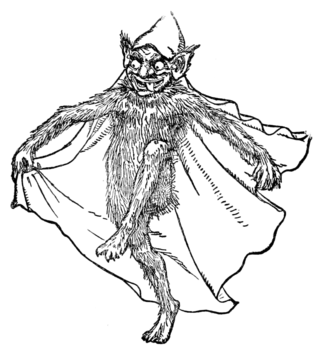Related Research Articles

The púca, pucapwca, pooka, phouka, puck is a creature of Celtic, English, and Channel Islands folklore. Considered to be bringers both of good and bad fortune, they could help or hinder rural and marine communities. Púcaí can have dark or white fur or hair. The creatures were said to be shape-changers that could take the appearance of horses, goats, cats, dogs, and hares. They may also take a human form, which includes various animal features, such as ears or a tail.

The bogeyman is a mythical creature used by adults to frighten children into good behaviour. Bogeymen have no specific appearance and conceptions vary drastically by household and culture, but they are most commonly depicted as masculine or androgynous monsters that punish children for misbehaviour. The bogeyman and conceptually similar monsters can be found in many cultures around the world. Bogeymen may target a specific act or general misbehaviour, depending on the purpose of invoking the figure, often on the basis of a warning from an authority figure to a child. The term is sometimes used as a non-specific personification of, or metonym for, terror, and sometimes the Devil.

The manananggal is a mythical creature in the Philippines that is able to separate its upper torso from the lower part of its body. Their fangs and wings give them a vampire-like appearance.
Nordic folklore is the folklore of Denmark, Norway, Sweden, Iceland and the Faroe Islands. It has common roots with, and has been mutually influenced by, folklore in England, Germany, the Low Countries, the Baltic countries, Finland and Sápmi. Folklore is a concept encompassing expressive traditions of a particular culture or group. The peoples of Scandinavia are heterogenous, as are the oral genres and material culture that has been common in their lands. However, there are some commonalities across Scandinavian folkloric traditions, among them a common ground in elements from Norse mythology as well as Christian conceptions of the world.

Little people have been part of the folklore of many cultures in human history, including Ireland, Greece, the Philippines, the Hawaiian Islands, New Zealand, Flores Island, Indonesia, and Native Americans.

The kallikantzaros is a malevolent creature in Southeast European and Anatolian folklore. Stories about the kallikantzaros or its equivalents can typically be found in Greece, Bulgaria, Turkey, Serbia, Albania, Bosnia, and Cyprus. Kallikantzaroi are believed to dwell underground but come to the surface during the twelve days of Christmas, from 25 December to 6 January.

Aswang is an umbrella term for various shape-shifting evil creatures in Filipino folklore, such as vampires, ghouls, witches, viscera suckers, and transforming human-beast hybrids. The aswang is the subject of a wide variety of myths, stories, arts, and films, as it is well known throughout the Philippines. Spanish colonists noted that the aswang was the most feared among the mythical creatures of the Philippines, even in the 16th century. Although with no specific motive other than harming others, their behavior can be interpreted as an inversion of the traditional Filipino's values. The aswang is especially popular in southern parts of Luzon, and some parts of Mindanao and Visayas, especially the Visayan province of Capiz.
Magical creatures are an aspect of the fictional Wizarding World contained in the Harry Potter series and connected media originally created by British author J. K. Rowling. Throughout the seven main books of the series, Harry and his friends encounter many of these creatures on their adventures in Hogwarts, the Forbidden Forest, or other locations throughout the Wizarding World. In addition, students learn to take care of creatures such as hippogriffs and unicorns in the Care of Magical Creatures class at Hogwarts. Rowling has also written Fantastic Beasts and Where to Find Them, a guide to the magical beasts found in the series, and based on the fictional textbook of the same name written by Newt Scamander and used by students at Hogwarts.

Werehyena is a neologism coined in analogy to werewolf for therianthropy involving hyenas. It is common in the folklore of the Arabian Peninsula, the Levant, North Africa, the Horn of Africa, and the Near East as well as some adjacent territories. Unlike werewolves and other therianthropes, which are usually portrayed as being originally human, some werehyena lore tells of how they can also be hyenas disguised as humans.

Brazilian mythology is the subset of Brazilian folklore with cultural elements of diverse origin found in Brazil, comprising folk tales, traditions, characters and beliefs regarding places, people, and entities. The category was originally restricted to indigenous elements, but has been extended to include:
Pedro Penduko is a Filipino comic book character created by National Artist for Literature Francisco V. Coching. The character, who is styled as a folk hero, debuted in the magazine Liwayway in 1954.

The Hidebehind is a nocturnal fearsome critter from American folklore that preys upon humans that wander the woods, and was blamed for the disappearances of early loggers when they failed to return to camp. As its name suggests, the Hidebehind is said to be able to conceal itself. When an observer attempts to look directly at it, the creature quickly hides behind an object or behind the observer and therefore cannot be directly seen. The Hidebehind supposedly uses this ability to stalk human prey without being observed and to attack them without warning. Said victims, including lumberjacks and others who frequent the forests, are then dragged back to the creature's lair to be devoured. The creature subsists chiefly upon the intestines of its victim and has a severe aversion to alcohol, which is therefore considered a sufficient repellent. Tales of the hidebehind may have been used as an explanation of strange noises in the forest at night. Early accounts describe Hidebehinds as large, powerful animals, despite the fact that no one was able to see them.

The Bridgewater Triangle is an area of about 200 square miles (520 km2) within southeastern Massachusetts in the United States, claimed to be a site of alleged paranormal phenomena, ranging from UFOs to poltergeists, and other spectral phenomena, various bigfoot-like sightings, giant snakes and thunderbirds. The term was coined by New England based cryptozoologist Loren Coleman.

Colombian folklore are beliefs, customs and cultural traditions in Colombia.
Mythic humanoids are legendary, folkloric, or mythological creatures that are part human, or that resemble humans through appearance or character. Each culture has different mythical creatures that come from many different origins, and many of these creatures are humanoids. They are often able to talk and in many stories they guide the hero on their journey.

Legends of vampires have existed for millennia; cultures such as the Mesopotamians, Hebrews, ancient Greeks, and Romans had tales of demonic entities and blood-drinking spirits which are considered precursors to modern vampires. Despite the occurrence of vampire-like creatures in these ancient civilizations, the folklore for the entity known today as the vampire originates almost exclusively from early 18th-century Southeastern Europe, particularly Transylvania as verbal traditions of many ethnic groups of the region were recorded and published. In most cases, vampires are revenants of evil beings, suicide victims, or witches, but can also be created by a malevolent spirit possessing a corpse or a living person being bitten by a vampire themselves. Belief in such legends became so rife that in some areas it caused mass hysteria and even public executions of people believed to be vampires.

A goblin is a small, grotesque, monstrous creature that appears in the folklore of multiple European cultures. First attested in stories from the Middle Ages, they are ascribed conflicting abilities, temperaments, and appearances depending on the story and country of origin, ranging from mischievous household spirits to malicious, bestial thieves. They often have magical abilities similar to a fairy or demon, such as the ability to shapeshift.
Maushop is a mythical hero and giant from Wampanoag folklore. He is said to have several companions, including a giant frog and his wife Granny Squannit.
Granny Squannit is a mythological figure from Wampanoag folklore. She is the wife of the giant Maushop and can be either a small woodland or sea creature.
References
- ↑ Hoffman, Charles Fenno (1850). The Poems of Charles Fenno Hoffman. D. Appleton & Co. p. 211.
- ↑ Theresa Bane (30 August 2013). Encyclopedia of Fairies in World Folklore and Mythology. McFarland. pp. 284–. ISBN 978-1-4766-1242-3.
- 1 2 The Good Giants And The Bad Pukwudgies. Jean Fritz; illustrations by Tomie de Paola. Putnam, 1982
- ↑ "Pukwudgies, little people of the Algonquian tribes (Pukwudgie, Puckwudgie, Bagwajinini)".